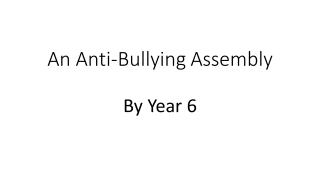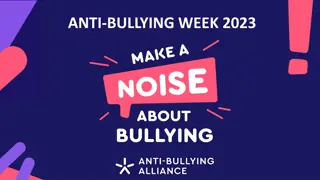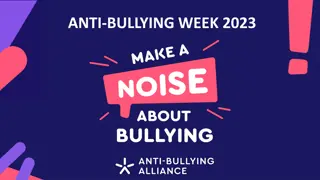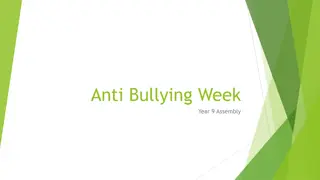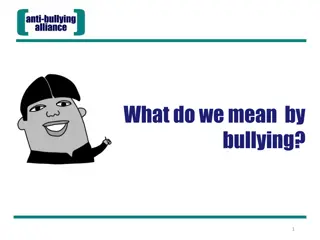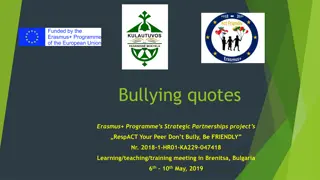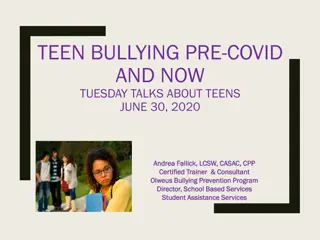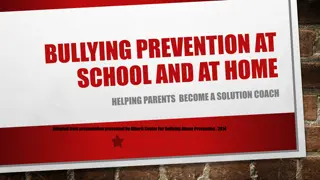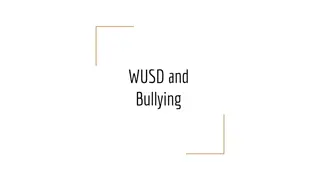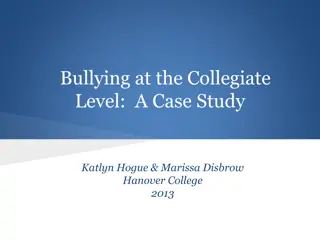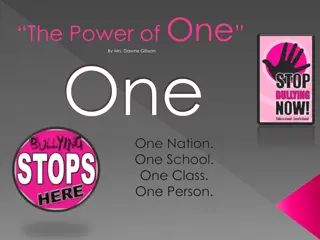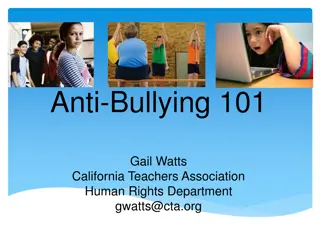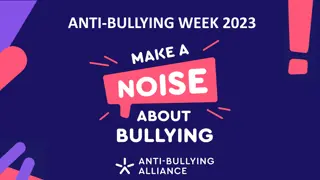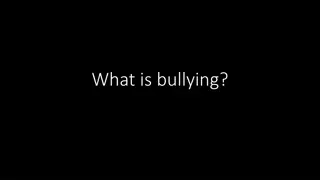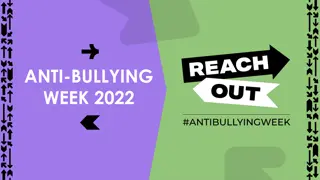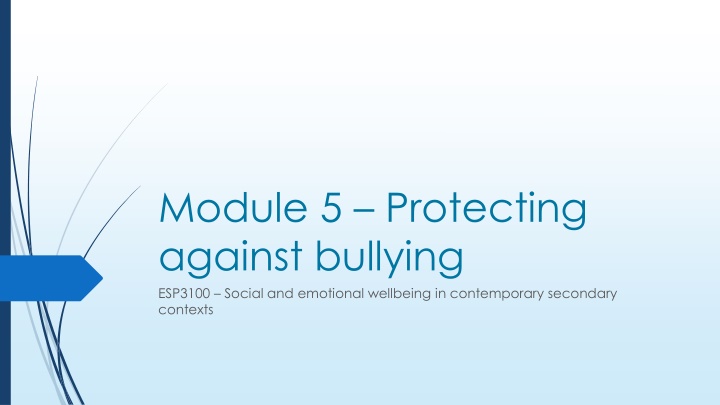
Protecting Against Bullying: Understanding and Addressing Power Imbalances
Explore the definition of bullying, examples of power imbalances, and behaviors that constitute bullying. Learn how ongoing and repeated misuse of power in relationships can lead to physical and psychological harm. Discover strategies to prevent and address bullying in contemporary secondary contexts.
Download Presentation

Please find below an Image/Link to download the presentation.
The content on the website is provided AS IS for your information and personal use only. It may not be sold, licensed, or shared on other websites without obtaining consent from the author. If you encounter any issues during the download, it is possible that the publisher has removed the file from their server.
You are allowed to download the files provided on this website for personal or commercial use, subject to the condition that they are used lawfully. All files are the property of their respective owners.
The content on the website is provided AS IS for your information and personal use only. It may not be sold, licensed, or shared on other websites without obtaining consent from the author.
E N D
Presentation Transcript
Module 5 Protecting against bullying ESP3100 Social and emotional wellbeing in contemporary secondary contexts
USQ MyOpinion Week 4 & 5 Check-in Pilot Just a reminder to please fill out this survey, it would mean a lot to me to see if this course is helping you and meeting your needs. Thanks!
Is it bullying when Someone calls you a name? Gets you to do their homework everyday all year or threatens you if you refuse? Refuses to include you at lunch? Refuses to include you and won t let anyone else include you? Refuses to include you and won t let anyone else include you all term? Spreads rumours about you? Comments on all of your facebook photos about how ugly you are?
Definition of bullying Bullying is an ongoing misuse of power in relationships through repeated verbal, physical and/or social behaviour that causes physical and/or psychological harm. It can involve an individual or a group misusing their power over one or more persons. Bullying can happen in person or online, and it can be obvious (overt) or hidden (covert). Bullying in any form or for any reason can have long-term effects on those involved, including bystanders. Single incidents and conflict or fights between equals, whether in person or online, are not defined as bullying. (www.bullyingnoway.gov.au)
Misuse of power in a relationship https://bullyingnoway.gov.au/resources/videos/pages/videoplayer.aspx?Vi deoID=86
Misuse of power in a relationship Give an example of a power imbalance where it would be considered bullying. Give an example of a power imbalance but it wouldn t be considered bullying.
Ongoing and Repeated https://bullyingnoway.gov.au/resources/videos/pages/videoplayer.aspx?Vi deoID=102
Ongoing and Repeated Give an example of ongoing and repeated behaviour where it would be considered bullying. Give an example of ongoing and repeated behaviour but it wouldn t be considered bullying.
Behaviours that can cause harm https://bullyingnoway.gov.au/resources/videos/pages/videoplayer.aspx?Vi deoID=94
Behaviours that can cause harm Give an example of a behaviour that can cause harm where it would be considered bullying. Give an example of a behaviour that can cause harm but it wouldn t be considered bullying.
Different perspectives on bullying Individual perspective locates the source of the problem within the individual. It leads to solutions which focus on identifying who is involved in bullying and modifying their behaviour. Socio-ecological perspective locates the source of the problem within the relationships between people as they interact within the values and norms of the wider culture. It leads to solutions which focus on modifying the attitudes and social norms in the school and wider community. Give an example of bullying which could be seen as predominantly based on an individual perspective. Given an example of bullying which could be seen as predominantly based on a socio-ecological perspective
Group teaching In your group, you will be asked to read one of the following sections from Research snapshot from a literature reviewby Australia s safe and supportive school communities working group: Who is involved in bullying? What are the impacts of bullying? What is the role of school culture and school climate in countering bullying? What is the role of school policy? What evidence-based practices can schools adopt? Please read, discuss and summarise your section, ready to report back to the rest of the class.
Student Wellbeing Framework Looking at the Student Wellbeing Framework, how can each section address bullying? Leadership Inclusion Student Voice Partnerships Support
Cyberbullying Cyberbullying is the use of technology to bully a person or group with the intent to hurt them socially, psychologically or even physically. It can occur in many ways, including: Abusive texts and emails Hurtful messages, images or videos Imitating others online Excluding others online Humiliating others online Nasty online gossip and chat
How can you support a student who is being cyberbullied? Thank them for talking to you and let them know you will follow the school s procedure for dealing with bullying Suggest they do the following things: Don t retaliate or respond as it could be used against them Block the bully and change their privacy settings Report the abuse to the service (facebook, Instagram etc) and get others to as well Collect any evidence keep phone messages, take screen shots and print emails Do something they enjoy Remind them that they didn t ask for this no one deserves to be bullied and they will get through it
How can teachers respond if a student tells you they are being bullied? Apart from following the school s procedure, it is essential that we help our students to feel as in control as possible. We can do this by helping them to build resilience and develop coping strategies in the short term. Some strategies may include: Assertiveness skills SAFE coping procedures
Assertiveness skills Ask for what you want calmly Express your rights State your feelings Be confident and firm, using your voice, eye contact and posture Use I messages
SAFE coping procedure Solve it by yourself stand up tall, look the person in the eye and say in a strong voice Stop! I don t like it when you Ask a friend tell a friend what is happening and ask them to be with you while you repeat step 1 Find a teacher seek out a teacher and report what is happening. Tell the teacher what steps you have taken Explore your options for example, tell a parent or another adult.
Reporting bullying Research typically underestimates the rates of bullying as students may be reluctant to report it as they fear not being believed, fear of making things worse or not having their concerns appropriately addressed by relevant adults. Responses by staff and others which are supportive, measured and respectful reassure students that their reports will be taken seriously and handled appropriately Schools should make sure all students know how to report bullying. Systems for reporting need to be well understood, easy to access and confidential.
How Australian schools respond The primary aim of the school s response is to restore a positive learning environment for all students There must be a publically available behaviour and/or bullying policy and procedure document which defines bullying and how it differs from other types of conflict or aggression, so they are able to respond appropriately. It is important that all members of a school community have a shared understanding of the different types of inappropriate behaviour of students, not just bullying. The second aim of the school s response is to avoid escalation of issues or causing more harm Read the School Response Flow Chart: Student Bullying for a general procedure (available on StudyDesk)
Restoring Relationships The aims for schools when responding to bullying are: To find a positive solution for everyone To stop it happening again To restore the relationships between the students involved Regardless of perceived severity, all cases of bullying require attention from the school even if the student being bullied does not appear particularly upset Methods of response: Traditional disciplinary approach Strengthening the target Mediation Support group method Restorative practice Method of shared concern
Why is this important? Oyston v St Patrick s College (2013) Plaintiff was bullied by her classmates on a regular basis Became suicidal and paramedics were called to the school more than once School was aware of risk of psychiatric injury and failed to exercise its duty of care Had anti-bullying policy but did not follow it nor did the school do enough to manage the bullying Mere counselling of victim is not adequate

